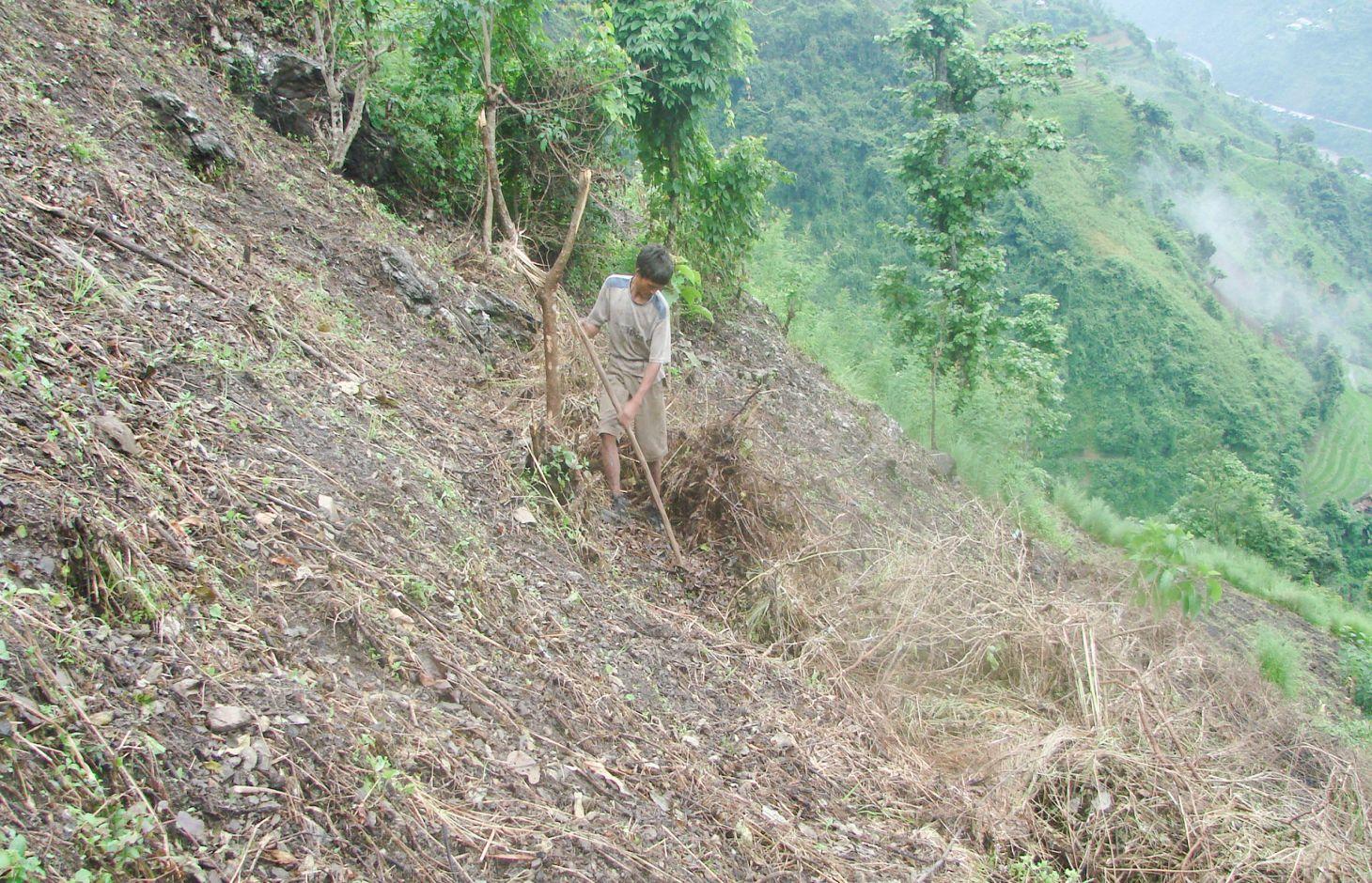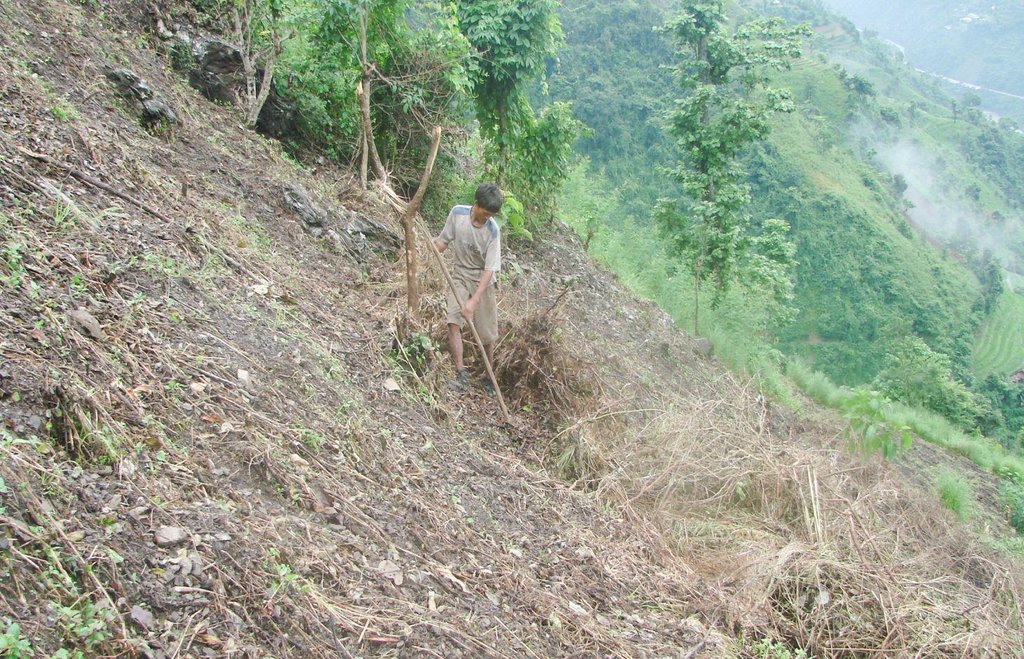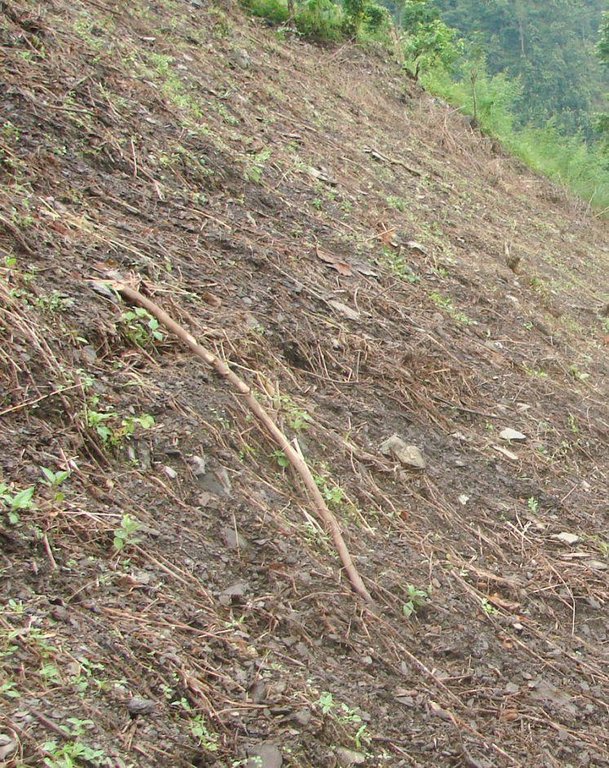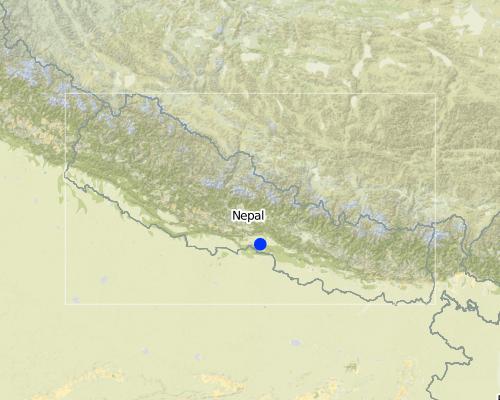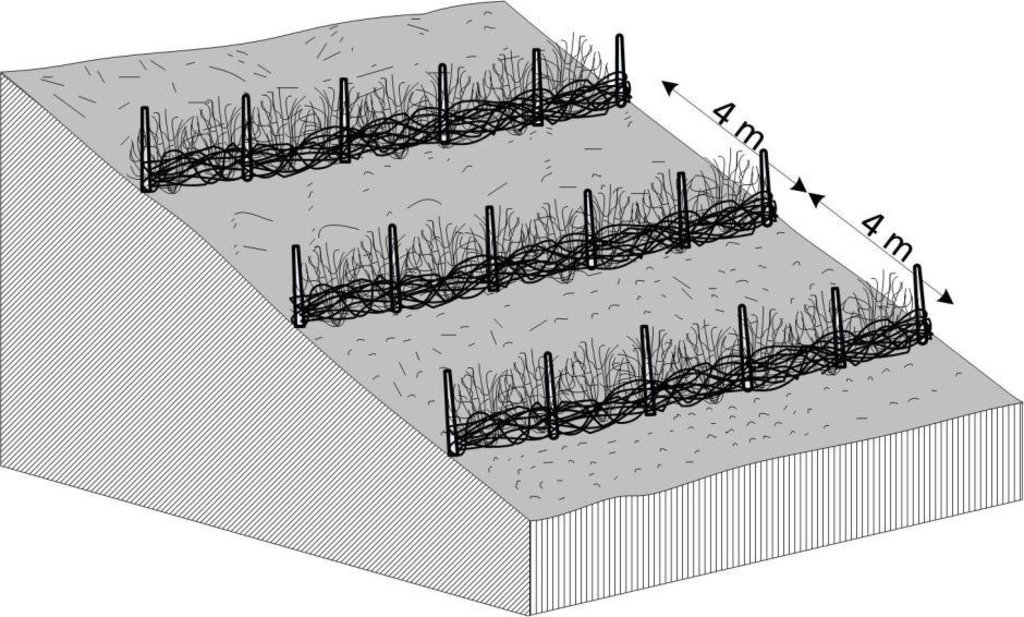Contour Bunding [尼泊尔]
- 创建:
- 更新:
- 编制者: Shreedip Sigdel
- 编辑者: –
- 审查者: David Streiff
Bhajo Rakhne (Main Contributor: Bir Bahadur Tamang, LI-BIRD)
technologies_1683 - 尼泊尔
查看章节
全部展开 全部收起1. 一般信息
1.2 参与该技术评估和文件编制的资源人员和机构的联系方式
SLM专业人员:
Tamang Bir Bahadur
+977 61 526834 / 9746005992
btamang@libird.org / info@libird.org
LI-BIRD
Gairapatan, Pokhara, Nepal, P.O. Box 324
尼泊尔
有助于对技术进行记录/评估的机构名称(如相关)
Local Initiatives for Biodiversity, Research, and Development (LI-BIRD) - 尼泊尔有助于对技术进行记录/评估的机构名称(如相关)
ICIMOD International Centre for Integrated Mountain Development (ICIMOD) - 尼泊尔1.3 关于使用通过WOCAT记录的数据的条件
(现场)数据是什么时候汇编的?:
01/03/2013
编制者和关键资源人员接受有关使用通过WOCAT记录数据的条件。:
是
2. SLM技术的说明
2.1 技术简介
技术定义:
A traditional low-cost method of soil conservation suitable for sloping land; it promotes water retention and helps prevent erosion.
2.2 技术的详细说明
说明:
Contour bunding is a proven sustainable land management practice for marginal, sloping, and hilly land where the soil productivity is very low. It is widely adopted by the ethnic minorities of Nepal who practice the shifting cultivation system of farming. Over generations, they have successfully used this technology to control soil erosion, promote water retention, and increase crop production. It has a high probability of replication because it is simple to implement, is low cost, and makes the maximum use of local resources.
Purpose of the Technology: Farmers use a multi-step process to promote the formation of rough terraces along contour lines on sloping land. First the vegetation on the shifting cultivation plot (mostly fodder and forage trees and bushes) is cut down and the leaves and small twigs removed from the branches by slashing. All the material is left on the surface to dry. The leaves and twigs gradually decompose. After a few weeks, the remaining dry material is rolled into bundles and arranged along contour lines. The material is anchored with pegs, stones, and (where possible) tree stumps. This is the beginning of the contour bund. The farmers then incorporate the remaining leaf litter and decomposed organic matter into the soil between the bunds and plant crops. Over time, as the soil gradually deposits above each bund and is eroded below, rough terraces are formed. The process is labour intensive and farmers need to regularly check and maintain the bunds to allow the soil to collect.
Establishment / maintenance activities and inputs: Contour bunding is relatively easy to establish and maintain since it does not require external inputs and local unskilled labourers can make them using locally available woody materials. It is also both sustainable and ecofriendly since there are no external inputs and no organic matter is burned in the process.
The use of contour bunding is limited by the fact that it is labour intensive and that bunding cannot be implemented during the fallow period of the shifting cultivation cycle, thus it can only be applied on a plot for two years (the cultivation period of the shifting cultivation cycle).
2.3 技术照片
2.5 已应用该技术的、本评估所涵盖的国家/地区/地点
国家:
尼泊尔
有关地点的进一步说明:
Chitwan, Tanahu, Gorkha, Dhading and Makawanpur
Map
×2.6 实施日期
如果不知道确切的年份,请说明大概的日期:
- 50多年前(传统)
2.7 技术介绍
详细说明该技术是如何引入的:
- 作为传统系统的一部分(> 50 年)
3. SLM技术的分类
3.1 该技术的主要目的
- 改良生产
- 减少、预防、恢复土地退化
3.2 应用该技术的当前土地利用类型

农田
- 一年一作

混合(作物/放牧/树木),包括农林
- 农林业
注释:
Major land use problems (compiler’s opinion): Shifting cultivation is a traditional farming system practice used by the ethnic minorities who farm marginal, hilly, and sloping land. Erratic rainfall and improper land use practices all contribute to land Rock phosphate is not always available -> crushed stone dust can be substituted. degradation.
Livestock is grazing on crop residues
3.3 有关土地利用的更多信息
该技术所应用土地的供水:
- 雨养
每年的生长季节数:
- 2
3.4 该技术所属的SLM组
- 改良的地面/植被覆盖
- 横坡措施
3.5 技术传播
具体说明该技术的分布:
- 均匀地分布在一个区域
如果该技术均匀地分布在一个区域上,请注明覆盖的大致区域。:
- 1-10 平方千米
3.6 包含该技术的可持续土地管理措施

结构措施
- S1:阶地
3.7 该技术强调的主要土地退化类型

土壤水蚀
- Wt:表土流失/地表侵蚀
注释:
Main causes of degradation: over-exploitation of vegetation for domestic use, Heavy / extreme rainfall (intensity/amounts) (Natural soil Erosion), population pressure
3.8 防止、减少或恢复土地退化
具体数量名该技术与土地退化有关的目标:
- 减少土地退化
4. 技术规范、实施活动、投入和成本
4.1 该技术的技术图纸
4.2 技术规范/技术图纸说明
Contour bunding on sloping land; after leafy matter is slashed and allowed to dry it is gathered into bunds and anchored into place using locally available materials such as twigs and stones; note that the bunds are typically spaced about
4 m apart.
Technical knowledge required for land users: moderate
Main technical functions: control of dispersed runoff: retain / trap
Secondary technical functions: increase in organic matter, increase / maintain water stored in soil
4.3 有关投入和成本计算的一般信息
具体说明成本和投入是如何计算的:
- 每个技术区域
注明尺寸和面积单位:
ha
具体说明成本计算所用货币:
- 美元
注明雇用劳工的每日平均工资成本:
2.70
4.4 技术建立活动
| 活动 | 措施类型 | 时间 | |
|---|---|---|---|
| 1. | The vegetation on the plots (leafy fodder and others) is slashed and allowed to dry on the sloping land.The dry materials are collected along contour lines and anchored into place using locally available materials.The land between the bund lines is enriched with the leaf litter and crops are planted. | 结构性的 | few weeks (16 days) |
4.5 技术建立所需要的费用和投入
| 对投入进行具体说明 | 单位 | 数量 | 单位成本 | 每项投入的总成本 | 土地使用者承担的成本% | |
|---|---|---|---|---|---|---|
| 劳动力 | Building rough terraces | persons/day/ha | 16.0 | 2.7 | 43.2 | 100.0 |
| 技术建立所需总成本 | 43.2 | |||||
4.6 维护/经常性活动
| 活动 | 措施类型 | 时间/频率 | |
|---|---|---|---|
| 1. | The bundling is periodically checked and lapsed areas are repaired as needed | 结构性的 | few days |
4.7 维护/经常性活动所需要的费用和投入(每年)
| 对投入进行具体说明 | 单位 | 数量 | 单位成本 | 每项投入的总成本 | 土地使用者承担的成本% | |
|---|---|---|---|---|---|---|
| 劳动力 | Maintaining area | persons/day/ha | 4.0 | 2.7 | 10.8 | 100.0 |
| 技术维护所需总成本 | 10.8 | |||||
4.8 影响成本的最重要因素
描述影响成本的最决定性因素:
The cost of implementing this technology is dependent on the gradient of the slope (and other geographical features) and the availability of labour. All costs and amounts are rough estimates by the technicians and authors.
5. 自然和人文环境
5.1 气候
年降雨量
- < 250毫米
- 251-500毫米
- 501-750毫米
- 751-1,000毫米
- 1,001-1,500毫米
- 1,501-2,000毫米
- 2,001-3,000毫米
- 3,001-4,000毫米
- > 4,000毫米
农业气候带
- 半湿润
Thermal climate class: subtropics
5.2 地形
平均坡度:
- 水平(0-2%)
- 缓降(3-5%)
- 平缓(6-10%)
- 滚坡(11-15%)
- 崎岖(16-30%)
- 陡峭(31-60%)
- 非常陡峭(>60%)
地形:
- 高原/平原
- 山脊
- 山坡
- 山地斜坡
- 麓坡
- 谷底
垂直分布带:
- 0-100 m a.s.l.
- 101-500 m a.s.l.
- 501-1,000 m a.s.l.
- 1,001-1,500 m a.s.l.
- 1,501-2,000 m a.s.l.
- 2,001-2,500 m a.s.l.
- 2,501-3,000 m a.s.l.
- 3,001-4,000 m a.s.l.
- > 4,000 m a.s.l.
5.3 土壤
平均土层深度:
- 非常浅(0-20厘米)
- 浅(21-50厘米)
- 中等深度(51-80厘米)
- 深(81-120厘米)
- 非常深(> 120厘米)
土壤质地(表土):
- 粗粒/轻(砂质)
表土有机质:
- 中(1-3%)
如有可能,附上完整的土壤描述或具体说明可用的信息,例如土壤类型、土壤酸碱度、阳离子交换能力、氮、盐度等。:
Soil fertility is low
Soil water storage capacity is very low
5.4 水资源可用性和质量
地下水位表:
> 50米
地表水的可用性:
匮乏/没有
5.6 应用该技术的土地使用者的特征
生产系统的市场定位:
- 生计(自给)
非农收入:
- 收入的10-50%
相对财富水平:
- 贫瘠
个人或集体:
- 个人/家庭
机械化水平:
- 手工作业
说明土地使用者的其他有关特征:
Land users applying the Technology are mainly disadvantaged land users
Population density: 10-50 persons/km2
Annual population growth: 2% - 3%
5.7 应用该技术的土地使用者拥有或租用的平均土地面积
- < 0.5 公顷
- 0.5-1 公顷
- 1-2 公顷
- 2-5公顷
- 5-15公顷
- 15-50公顷
- 50-100公顷
- 100-500公顷
- 500-1,000公顷
- 1,000-10,000公顷
- > 10,000公顷
这被认为是小规模、中规模还是大规模的(参照当地实际情况)?:
- 小规模的
5.8 土地所有权、土地使用权和水使用权
土地所有权:
- 个人,未命名
土地使用权:
- 个人
用水权:
- 自由进入(无组织)
5.9 进入服务和基础设施的通道
健康:
- 贫瘠
- 适度的
- 好
教育:
- 贫瘠
- 适度的
- 好
技术援助:
- 贫瘠
- 适度的
- 好
就业(例如非农):
- 贫瘠
- 适度的
- 好
市场:
- 贫瘠
- 适度的
- 好
能源:
- 贫瘠
- 适度的
- 好
道路和交通:
- 贫瘠
- 适度的
- 好
饮用水和卫生设施:
- 贫瘠
- 适度的
- 好
金融服务:
- 贫瘠
- 适度的
- 好
6. 影响和结论性说明
6.1 该技术的现场影响
社会经济效应
生产
作物生产
木材生产
产品多样性
土地管理
收入和成本
农业投入费用
农业收入
收入来源的多样性
工作量
社会文化影响
食品安全/自给自足
健康状况
社区机构
SLM/土地退化知识
冲突缓解
livelihood and human well-being
注释/具体说明:
increased crop production, with associated increase in income and improved human health
生态影响
土壤
土壤水分
土壤覆盖层
土壤流失
养分循环/补给
土壤有机物/地下C
生物多样性:植被、动物
害虫/疾病控制
注释/具体说明:
birds, slugs, rodents
其它生态影响
Competition
注释/具体说明:
of water, sunlight and nutrients
habitat fragmentation
6.2 该技术的场外影响已经显现
下游洪水
下游淤积
缓冲/过滤能力
风力搬运沉积物
6.3 技术对渐变气候以及与气候相关的极端情况/灾害的暴露和敏感性(土地使用者认为的极端情况/灾害)
渐变气候
渐变气候
| 季节 | 气候变化/极端天气的类型 | 该技术是如何应对的? | |
|---|---|---|---|
| 年温度 | 增加 | 好 |
气候有关的极端情况(灾害)
气候灾害
| 该技术是如何应对的? | |
|---|---|
| 干旱 | 好 |
6.4 成本效益分析
技术收益与技术建立成本相比如何(从土地使用者的角度看)?
短期回报:
稍微积极
长期回报:
积极
技术收益与技术维护成本/经常性成本相比如何(从土地使用者的角度看)?
短期回报:
积极
长期回报:
非常积极
6.5 技术采用
- 大于 50%
如若可行,进行量化(住户数量和/或覆盖面积):
200 households in an area of 1 - 10 sq km (10 - 50 persons/sq km)
在所有采用这项技术的人当中,有多少人是自发地采用该技术,即未获得任何物质奖励/付款?:
- 90-100%
注释:
There is a moderate trend towards spontaneous adoption of the Technology
Comments on adoption trend: About 200 land user families have voluntarily adopted this technology in Tanahun, Chitawan, Gorkha, Dhading, and Makawanpur Districts of Nepal.
6.7 该技术的优点/长处/机会
| 编制者或其他关键资源人员认为的长处/优势/机会 |
|---|
|
Decreased soil erosion and increased productivity of the soil How can they be sustained / enhanced? Formation of permanent bunds and terraces; adds organic matter to the soil |
|
Natural terrace formation and decreasing slope gradient How can they be sustained / enhanced? Over time, as more soil deposits on the bunds, the gradient is naturally decreased |
|
As the organic matter content increases, humus soil is formed and the soil fertility increases How can they be sustained / enhanced? Continue to accumulate crop residues on the surface; these will decompose and increase the organic matter content of the soil |
6.8 技术的弱点/缺点/风险及其克服方法
| 编制者或其他关键资源人员认为的弱点/缺点/风险 | 如何克服它们? |
|---|---|
| Slashing contributes to the risk of forest fires | After drying, the slashed materials should be rolled out within a week |
| When too many trees are slashed it can promote landslides | Grow trees along the bunds; fodder trees are especially beneficial |
| Bunds may harbour biological pests such as rodents | Regular maintenance and pest control can help to limit unwanted wildlife |
7. 参考和链接
7.2 参考可用出版物
标题、作者、年份、ISBN:
Indigenous knowledge of farmers in the shifting cultivation areas of Western Nepal., Regmi, BR; Aryal, KP; Subedi, A; Shrestha, PK; Tamang, BB, 2001
链接和模块
全部展开 全部收起链接
无链接
模块
无模块


